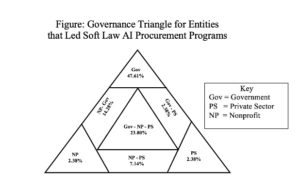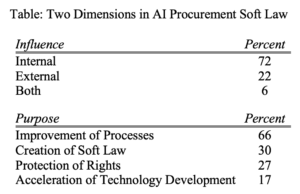
Soft law standards can promote responsible procurement of artificial intelligence systems.
The multiple ways that artificial intelligence (AI) affects society has captured significant global attention. An area of growing interest is the role that AI procurement can play in addressing the effects of this technology within the public and private sector.
One means of evaluating developments in AI procurement is to analyze the text of soft law programs. By “soft law,” I mean any initiative that creates substantive expectations about how AI should be designed and deployed, which is not directly enforced by government. They are “soft” in comparison with hard law that takes the form of legislation or regulation.
These soft law programs reveal the positions expressed about AI by many entities—private sector, nonprofits, and government—and they take the form of strategies, recommendations, principles, and best practices, among others.
In collaboration with Gary Marchant of Arizona State University, we created a database of AI soft law programs from 2001 to 2019. The database contains all the AI-related text associated with 634 programs from 64 unique geographic areas. The word “procurement” within this corpus is found 84 times in 44 programs throughout the database.
Subsequently, a total of 86 relevant statements were identified and compiled in a new database focused on procurement. As evident from the figure below, the vast majority of statements about AI procurement came from governmental entities (48 percent) or governmental entities issuing statements jointly with other organizations (40 percent). Interestingly, most mentions of procurement come from soft law initiatives that were created recently, as the average year of release is 2018.

Each procurement-related statement in the database was analyzed using two dimensions, as indicated in the table below. The first dimension identified the directionality of influence. In other words, statements can either be meant to guide stakeholders within the sphere of influence of the entity making them (internal), direct individuals or groups outside of it (external), or target both internal and external stakeholders (both).
Internal statements formed the largest group, with a 72 percent proportion of the total. They are found exclusively in organizations led by government or by governmental alliances, such as national governments, state or provincial institutions, or multilateral institutions like the European Union. Surprisingly, local government is represented in the form of guidance developed by the New York City’s Automated Decision Systems (ADS) Task Force.
External statements were found in 22 percent of the programs. These include governmental pronouncements targeting the private sector, private sector entities or associations providing guidelines to the AI stakeholder community, or nonprofits offering advice to government institutions. Only a varied, yet small, mix of statements (6 percent) are directed toward both internal and external stakeholders.

The second dimension describes the substantive purpose of the soft law text. For this dimension, relevant statements were categorized into four groups: improvement of processes, acceleration of technology development, creation of soft law, and protection of rights. It is important to note that each statement could be categorized with up to two purposes.
Improvement of processes was the most popular purpose of soft law procurement programs, reflected in 66 percent of statements. To qualify, a statement needed to express a suggestion for enhancing a procurement practice. For government agencies, a great example consisted of the guidelines created by the government of the United Kingdom (UK) in conjunction with the World Economic Forum (WEF). In this document, the UK and WEF provided concrete advice to public agencies about their AI procurement practices. Specifically, they direct government entities to “consider during the procurement process that acquiring a tool that includes AI is not a one-time decision; testing the application over its lifespan is crucial” and “ensure interoperability of AI solutions and require open licensing terms to avoid vendor lock-in.”
Similar advice is provided by actors outside of government. For instance, Microsoft offers a list of regional procurement standards and guidelines that developers should consider when deploying their AI-based technologies.
After improving processes, the second most popular purpose reflected in the database was the creation of soft law, which is present in 30 percent of the statements. Among these statements, organizations advocated the creation or improvement of soft law mechanisms to guide AI procurement. In New York City, for example, a task force dedicated to ADS suggested furthering a set of “best practices on ADS, including ADS procurement, data retention, and data sharing, to serve as a resource for agencies.”
Nonprofit organizations also issued statements prodding governments to take action in the realm of procurement. This was the case with C-Minds, which asked the Mexican government to “develop guidelines for smart AI procurement” and explained that “in order to better provide high-quality services for citizens, government needs to embrace technology.”
Ensuring and protecting rights was an express purpose found in 27 percent of the statements in the sample. All statements in this class mentioned the need for society to use procurement as a means of ensuring that the rights of individuals and organizations are guaranteed.
The Council of Europe, for instance, devoted an entire document to the impact of algorithms on human rights. In it, the body urged countries to “promote the development of algorithmic systems and technologies that enhance equal access to, and enjoyment of, human rights and fundamental freedoms through procurement.” UNESCO has, in a similar vein, recommended that governments “use public procurement and funding as a driver of gender equality in AI.”
Finally, the purpose of accelerating technological development was found in 17 percent of the examined statements. This group contained ideas about the role of procurement in fostering the creation and deployment of AI technology in the marketplace, mostly the private sector. The government of France, for example, affirmed that its procurement policies should “support European industries.” Similarly, Korea issued a statement to “enable businesses to establish early dominance in intelligent IT ecosystems.”
A number of trade associations around the world advocated in favor of using public procurement to fund AI development. This is the case of a regional medical technology industry association which stated that procurement should be used both to build “innovation and ensure trustworthy AI.”
This research reveals the extent to which the conversation about procurement exists within the world of soft law AI governance. Predominantly, government is the main participant in and target of these discussions.
This protagonism is well-deserved. Public entities have a variety of powers for setting the optimal marketplace conditions in the AI field. As large customers, they can design incentives for the creation and growth of responsible AI use by firms. As arbiters of social norms, they can push for beneficial soft laws that spread throughout the rest of the country. As stewards of public resources, they can improve their own operations through AI deployment.
The bespoke procurement database in this piece reflects growing interest in the relationship between this field and AI. Attention to the relevance of this relationship will undoubtedly increase in importance as AI technology gains more capabilities to serve humanity.
This essay is part of a nine-part series entitled Artificial Intelligence and Procurement.




